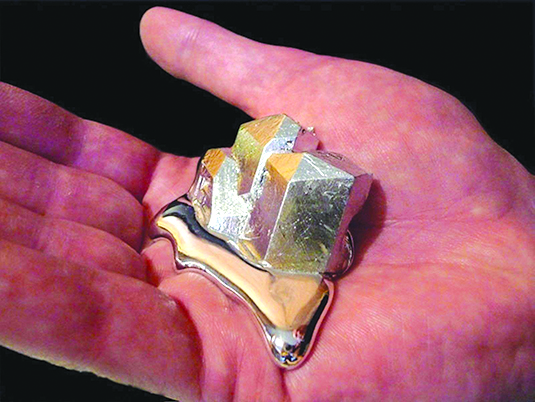Guess what would happen if you held a small piece of the silvery metal gallium in your hand? In a few minutes, it would melt and soon trickle through your fingers! Gallium, being one of just four metals that liquify very close to room temperature, though not at room temperature (25°C) like Mercury, just the warmth of your palm would be enough to melt it. The other three metals are rubidium, caesium, and francium. However, the difference between gallium and these others is that gallium is considered non-toxic and safe to hold, whereas handling the others could result in serious injuries to your hand or adverse effects on your health.
And guess how we routinely come in close contact with this interesting element, perhaps every day? Smartphones, calculators, household thermometers, high-speed internet connections in homes and offices… gallium is present in all of these.
Gallium was also the first element whose existence and main properties the Russian chemist Dmitri Mendeleev predicted even before it was discovered. Back in 1871, while working on his path-breaking periodic table and arranging elements according to their atomic mass, Mendeleev had found there were gaps into which none of the known elements could fit. However, being confident about the table he was creating, he realised the gaps were actually space-holders for yet-to-be-discovered elements.
One such gap he had to leave was for the element with atomic number 31. Mendeleev, however, knew that the unknown element would have properties similar to those of aluminium—the element occupying the spot just above it—and therefore boldly named it eka-aluminium, eka being the Sanskrit word for the numeral ‘one’. Mendeleev used the prefixes eka, dvi, and tri (Sanskrit for one, two, and three) for undiscovered elements to signify how many places down from a known element in the same group they would have to be positioned in his periodic table. He thus predicted the existence of eka-boron (scandium), eka-manganese (technetium), and dvi-manganese (rhenium), among others.
Gallium is not found in its element form in nature and occurs as a trace element in coal, bauxite, and other minerals. It is generally obtained as a secondary product while processing bauxite.
Discovery
In 1875, four years after Mendeleev predicted the existence of gallium, a French chemist named Paul-Émile Lecoq de Boisbaudran discovered it using spectroscopy, something else the Russian great had predicted as gallium’s mode of discovery. While studying a zinc sulphide mineral called sphalerite through a spectroscope, Lecoq de Boisbaudran detected a spectrum of two violet lines that he concluded belonged to a new element. A year later, he succeeded in isolating a tiny amount of this element from a huge quantity of the mineral and found it had properties similar to that of aluminium. He named the newly discovered element gallium after Gallia—the ancient Latin name of his home country, France.
An interesting tussle took place between Mendeleev and the French chemist regarding the discovery of gallium through papers they published in scientific journals. From the different properties of the element mentioned by Lecoq de Boisbaudran, Mendeleev was sure it was the element he had earlier named eka-aluminium. Just one of the French scientist’s values differed from his. The density which the Frenchman had reported was 4.9 g/cm3, whereas he had predicted it to be 5.9 g/cm3. Mendeleev suggested this property be rechecked. To the Frenchman’s surprise, the Russian’s theoretical calculation of the density of gallium was found to be correct.
The strange case of the disappearing spoon
Grouped in the boron group (Group 13), and appearing between aluminium and indium, gallium’s properties lie between those of these two metals. Believed to be non-toxic, gallium in its ultra-pure form has a shiny, silvery appearance and has a smooth texture like glass. At room temperature it is a solid that is soft enough to be cut with a knife and can be melted with just the warmth of the palm, its melting point being just under 30°C.
This unique property makes gallium the right metal for making trick cutlery. Unsuspecting persons handed a shiny, metal spoon to stir sugar in their tea would find to their shock and surprise that the spoon disappears into the hot beverage right before their eyes. Unknown to them, the mystery metal would form a glittering puddle at the bottom of the cup. The gallium spoon trick is a classic prank that has to be seen to be believed.
What is also extraordinary about gallium is that it has the widest temperature range of any metal in the liquid state, remaining a liquid for a range of well over 2,000°C. While it melts just below 30°C, liquid gallium boils only at around 2200°C, a property that makes it ideal for use in high temperature thermometers.
Yet another notable property is the ease with which gallium forms low-melting alloys with other metals. For example, if a piece of gallium is left in contact with a piece of another metal like indium for some hours, the two metals will fuse to form a eutectic alloy having a much lower melting point than even pure gallium.
Glittering liquid gallium wets skin, glass, porcelain and other surfaces, a property that is exploited for making brilliant mirrors.
Growing use in modern times
Gallium is widely used in aerospace and defence applications, high-performance computers, hi-tech industrial equipment, telecommunications, and consumer products such as high-speed cellular telephones and other high-speed wireless devices.
Almost all of the gallium produced today is used for making gallium arsenide (GaAs), a compound that can convert electricity directly into laser light and is an essential component of LEDs used in smartphones and other devices. The market for gallium arsenide-based LEDs has also expanded into backlighting for LCD and notebook computer screens, digital cameras, DVD players, and lighting in motor vehicles.
GaAs is a key component in solar panels too, and was also used in the panels on the Mars Exploration Rover. GaAs has many advantages over silicon. GaAs solar material is the most efficient in the world, producing more power for a particular surface area as compared to any other solar technology, and is also lightweight as compared to silicon-based solar material. This property is of critical importance when surface area is limited like for example on aircraft, cars or small satellites.
A recent application of gallium is in the production of copper indium gallium diselenide thin-film solar cells that can be produced in high volumes and by using less energy and raw materials as compared to crystalline silicon technology. These solar cells have a higher energy output even under bad weather conditions and are thin enough to be used for covering entire facades of buildings and also in decorative roof shingles and tiles.
Like gallium arsenide, gallium nitride (GaN) too is a promising semiconductor. It is used in LEDs, and also in Blu-ray technology and in pressure sensors for touch switches. As in the case of GaAs, GaN devices too are more efficient and can be smaller in size. Besides, GaN can withstand higher temperatures than silicon too.
Dislodging the mercury thermometer
The clinical mercury thermometer, for long a fixture in households and medical facilities, is on the way to becoming obsolete much like glass syringes and other devices like typewriters and polaroid cameras. The newer gallium-based medical thermometers are fast replacing them.
The reason for cracking down on mercury is the damage caused by its release into the environment. More than swallowing mercury, a toxic element, (though the minute amount in a ‘fever thermometer’ does not pose any great danger if swallowed) major health problems could result from inhaling vapours of the element. Pure mercury and its compounds are known to cause neurological and other ailments.
Therefore, for over a decade now, many governments, especially in the developed world, have either banned the use of medical thermometers containing mercury or have introduced campaigns to phase them out. Some of the newer, mercury-free clinical thermometers contain a low-melting gallium alloy called Galinstan that comprises gallium, indium, and tin, and has a melting point of -19°С.
Displacing silicon as the backbone of the electronics industry
Gallium has already established itself as being fundamentally important to the semiconductor industry and is fast emerging as being critical to the future of the power electronics industry in particular. Over a century ago, with its discovery, gallium helped confirm that Mendeleev was not a crackpot theorist, like some scientists of his time believed, but that his periodic table was indeed a highly useful tool for the classification and study of elements. Given its impact on ‘smarter’ and cutting-edge technologies, scientists now believe gallium will prove to be the silicon of the future.
References
1. Marshall Brennan: Gregarious Gallium – Nature Chemistry, Vol. 6, 20 November 2014, https://www.nature.com/articles/nchem.2116
2. Traci Pedersen: Facts about Gallium – LiveScience.com, 25 July, 2017, https://www.livescience.com/29476-gallium.html
3. ChemistryExplained.com: Gallium – http://www.chemistryexplained.com/elements/C-K/Gallium.html
4. Anne Marie Helmenstine: Gallium Facts – ThoughtCo.com, 02 October, 2018, https://www.thoughtco.com/gallium-facts-606537
5. Royal Society of Chemistry: Gallium – http://www.rsc.org/periodic-table/element/31/gallium
6. Oliver Sacks: Gallium – C & EN, 8 September, 2003
7. Chemicool.com: Gallium Element Facts – 17 October, 2012, https://www.chemicool.com/elements/gallium.html
8. Angela Chen: Gallium nitride is the silicon of the future – The Verge, 12 February, 2019, https://www.theverge.com/2018/11/1/18051974/gallium-nitride-anker-material-silicon-semiconductor-energy.
9
































